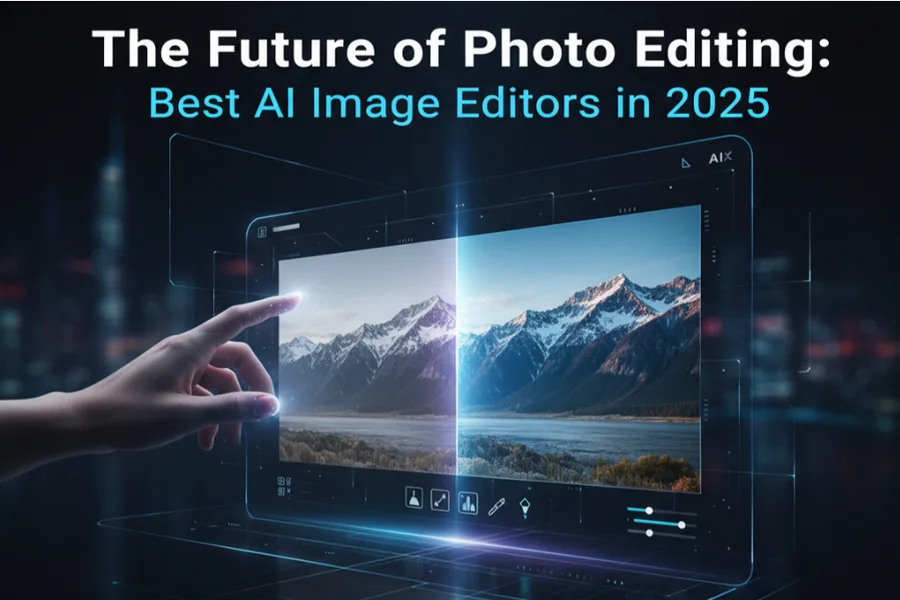As of November 2025, the difference between professional and AI-assisted photo editing has simply disappeared. Creators, marketers, and designers are now spending less time on manual adjustments and more time refining ideas, all thanks to a new generation of AI image editors that combine creativity with automation.
After testing dozens of platforms across real creative workflows, I narrowed down the five best AI image editors in 2025. Each one offers something unique, whether you’re a brand designer seeking precision, a content creator chasing speed, or a developer integrating AI visuals into your product.
Let’s start with a quick comparison.
Best AI Image Editors in 2025 at a Glance
| Tool | Best For | Modalities | Platforms | Free Plan | Key Strength |
| Magic Hour | Professional & creative-level photo editing | Image generation, enhancement, editing | Web | Yes | Best overall AI image editor with prompt free |
| Adobe Firefly | Professional designers & creative teams | Generative fill, text-to-image | Web, Desktop | Limited | Precision and pro-level control |
| Canva AI | Marketers & content creators | Photo editing, design generation | Web, Mobile | Yes | Intuitive and fast for everyday content |
| Fotor AI Editor | Casual users & freelancers | Retouching, filters, enhancements | Web, Mobile | Yes | Easy automation and templates |
| Pixlr AI | Browser-based editors | Background removal, filters, effects | Web | Yes | Lightweight and fast editing on any device |
1. Magic Hour: The Best Overall AI Image Editor of 2025
Magic Hour offers the best AI image editor with prompt free capabilities available today. If there’s one AI photo editor that truly balances creative freedom with intelligent automation, it’s Magic Hour. Built specifically for creators who want professional-grade quality without the complexity, it combines AI-powered editing, photo enhancement, and prompt-based generation in a seamless interface.
I’ve tested dozens of AI photo editors over the past year, and Magic Hour consistently stood out for its ability to understand creative intent. Whether you’re reimagining portraits, product photos, or marketing visuals, it feels less like a traditional editor and more like a visual collaborator.
Pros:
- Exceptional quality for both AI-generated and human-captured images
- Intuitive editing workflow, minimal learning curve
- Prompt-to-edit system delivers fast, context-aware results
- Built-in color grading and style transfer tools
- Fast rendering even with large image sizes
Cons:
- Limited offline functionality
- Advanced features currently optimized for Chrome browsers
Magic Hour makes image editing genuinely creative again. It’s the only AI editor I tested that could generate near-photorealistic edits from simple text inputs, and refine them precisely with brush-level control.
Price: Free plan available; Paid version starts around $10/month.
2. Adobe Firefly: The Power Tool for Professional Creators
Adobe Firefly represents Adobe’s most ambitious AI leap yet. Integrated deeply into Photoshop and the Creative Cloud ecosystem, it lets professionals perform context-aware fills, text-to-image generations, and real-time object manipulation with accuracy that feels near-magical.
If you already live inside the Adobe ecosystem, Firefly is almost a must-have. It excels at integrating AI into your existing creative pipeline rather than replacing it.
Pros:
- Professional-grade quality and precision
- Deep integration with Photoshop and Illustrator
- Extensive generative fill and image expansion tools
- Enterprise-grade IP protection and content credentials
Cons:
- Limited standalone functionality outside Adobe suite
- Subscription pricing can be expensive for individual users
When I tested Firefly for client mockups, its ability to extend and blend product imagery was unmatched. However, the tool’s complexity might feel overkill for everyday content creators.
Price: Included in Adobe Creative Cloud plans; limited free credits available.
3. Canva AI: The Everyday Creator’s Choice
If you’re creating marketing assets daily, like social posts, ads, presentations, Canva AI is your most practical companion. It merges an approachable drag-and-drop interface with smart AI tools like Magic Edit, Background Remover, and Text-to-Image generation.
In 2025, Canva’s AI capabilities have expanded to rival some standalone editors, making it ideal for teams that need quick, consistent visuals without relying on advanced design skills.
Pros:
- Extremely easy to use; minimal onboarding required
- Great for marketers and non-designers
- Strong collaboration tools for teams
- AI features embedded throughout the workflow
Cons:
- Limited depth for professional photo retouching
- Image generation quality varies across styles
For rapid content creation and consistent brand visuals, Canva AI remains unmatched in speed and simplicity. It won’t replace Photoshop or Magic Hour, but for quick-turnaround visuals, it’s one of the best tools to have.
Price: Free plan available; Pro starts at $12.99/month.
4. Fotor AI Editor: Smart, Lightweight, and Accessible
Fotor AI Editor is a surprisingly capable tool for quick retouching and image enhancement. It uses AI to automate tasks like blemish removal, skin smoothing, color correction, and style transformation, making it a great fit for freelancers and small studios.
During testing, I appreciated how fast Fotor processes images. Its results aren’t as polished as Firefly or Magic Hour, but for web and social use, it’s more than enough.
Pros:
- Simple, clean interface with fast performance
- AI-powered filters and one-click retouching
- Ideal for portrait and product photography
- Works smoothly on low-end devices
Cons:
- Limited manual fine-tuning tools
- Occasional inconsistencies in AI enhancements
Fotor is the tool you open when you need a quick, attractive edit, not a creative overhaul. It’s a strong all-rounder for light editing needs and beginners looking to explore AI-assisted design.
Price: Free plan available; Pro starts at $8.99/month.
5. Pixlr AI: Fast, Browser-Based AI Editing
Pixlr AI has been around for years as a free online photo editor, but its 2025 iteration introduces serious AI capabilities. The addition of smart background removal, AI auto-correction, and style filters has made it one of the most accessible AI photo tools available directly in your browser.
Pros:
- 100% browser-based, no downloads needed
- Excellent auto-enhancement features
- Great for quick edits, collages, and social media content
- Free version includes key AI tools
Cons:
- Not as advanced as desktop-based editors
- Occasional slow performance on large images
Pixlr AI is the go-to for users who need speed and simplicity. I often use it for quick thumbnail edits and social post adjustments, it’s perfect when you’re in a rush or working on a borrowed device.
Price: Free plan available; Premium from $7.99/month.
How I Chose These Tools
I spent several weeks testing each platform under real creative conditions, editing portraits, product photos, and marketing visuals. My evaluation was based on:
- AI Accuracy: How well the tool understands prompts and image context.
- Creative Control: The balance between automation and manual fine-tuning.
- Speed and Stability: Performance with high-resolution images.
- Output Quality: Final render sharpness, lighting, and realism.
- Ease of Use: How intuitive the interface feels for both pros and beginners.
- Value: Pricing vs. actual creative utility.
Each platform had their own speciality in different areas, but Magic Hour consistently offered the best balance between professional quality, user experience, and AI intelligence.
The 2025 AI Photo Editing Landscape
AI photo editing has evolved a lot in 2025. The market is shifting from simple “AI filter apps” to true co-creative tools, platforms that can interpret artistic intent, not just apply effects.
Three trends stand out:
- Prompt-to-Edit Interfaces: Tools like Magic Hour allow direct instruction-based editing (“brighten the face, soften the shadows”), blending language understanding with pixel-level control.
- Integrated AI Workflows: Adobe, Canva, and Fotor now embed AI editing directly into design ecosystems, cutting down the time from idea to export.
- Ethical and Authentic AI Generation: Content credentials, watermarking, and IP-safe models are becoming standard, ensuring professional compliance.
As these technologies converge, the next generation of editors will feel less like “tools” and more like creative assistants, intuitive, visual, and fast.
Final Takeaway
If you’re serious about creative-quality AI photo editing in 2025, Magic Hour is the clear leader. It delivers stunning results while staying easy to use, making it the best AI image editor with prompt free capabilities available today.
- Choose Magic Hour if you want the best balance of creativity and precision.
- Choose Adobe Firefly for professional-grade, studio-level control.
- Choose Canva AI for fast marketing visuals and content workflows.
- Choose Fotor AI for lightweight, smart photo enhancement.
- Choose Pixlr AI for instant browser-based editing.
Experiment with a few, your ideal editor will depend on your workflow, creative goals, and how much manual control you want to keep.
FAQs
- What is an AI image editor?
An AI image editor uses machine learning to automate editing tasks like background removal, retouching, and object replacement thus saving time while maintaining creative quality. - Are AI photo editors replacing traditional tools?
Not entirely. AI editors are speeding up workflows, but most professionals still combine them with traditional editing for final refinements. - Which AI photo editor is best for beginners?
Canva AI or Fotor AI are perfect for beginners. Both offer intuitive interfaces and high-quality outputs without requiring design skills. - Is AI-generated photo editing safe for commercial use?
Yes, as long as you’re using tools that comply with commercial licensing and IP standards. Platforms like Adobe Firefly and Magic Hour already include safeguards. - What’s next for AI image editing in 2026?
Expect real-time AI co-editing, voice-based commands, and smarter integrations with video and 3D design tools.





